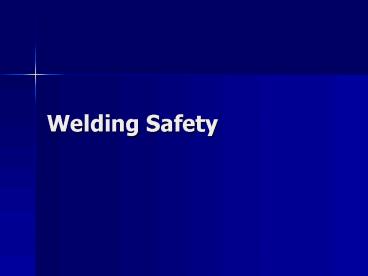Welding Safety - PowerPoint PPT Presentation
1 / 16
Title:
Welding Safety
Description:
Oxygen and acetylene cylinders must always be kept in an ... Never handle cylinders with oily, greasy hands. Keep oil and grease away from the cylinders. ... – PowerPoint PPT presentation
Number of Views:4403
Avg rating:3.0/5.0
Title: Welding Safety
1
Welding Safety
2
Safe Cylinder Handling and Storage
- The gases in oxygen and acetylene cylinders are
flammable and, under some conditions, explosive! - Oxygen and acetylene cylinders must always be
kept in an upright position, even while theyre
being moved. - Avoid banging cylinders against each other or
against another object. - Do not drag or roll cylinders across the floor.
3
Safe Cylinder Handling and Storage Cont.
- Never handle cylinders with oily, greasy hands.
Keep oil and grease away from the cylinders. - Do not store oxygen cylinders with acetylene
cylinders. Store them separately.
4
Different Types of Cylinders
- Oxy-fuel cylinders
- Oxygen cylinders
5
Ultraviolet Light
- Ultraviolet light is a form of radiation which is
not visible to the human eye. - Radiated energy, or radiation, is given off by
many objects a light bulb, a crackling fire, and
stars are some examples of objects which emit
radiation.
http//solar-center.stanford.edu/activities/uv.htm
l l
http//liftoff.msfc.nasa.gov/academy/universe/ultr
aviolet.html
6
Fire Prevention
- Keep the shop clean. Entrances, emergency exits,
and aisles must be kept clear at all times. - Know where the fire extinguishers are located and
read the instructions on the extinguishers. - Know what types of fires the extinguishers are
for and know how to use them in an emergency.
7
Fire Extinguishers
- Fire extinguishers are labeled according to the
type of fire on which they may be used. - Fires involving wood or cloth, flammable liquids,
electrical, or metal sources react differently to
extinguishers. - Using one type of extinguisher on the wrong type
of fire could be dangerous and make matters even
worse.
(Phoenix Fire Department)
8
Types of Extinguishers
- A Type A label is in a triangle on the
extinguisher. This extinguisher is used for
ordinary combustibles such as cloth, wood, rubber
and many plastics. - A Type B label is in a square on the
extinguisher. This extinguisher is used for
flammable liquid fires such as oil, gasoline,
paints, lacquers, grease, and solvents.
(Phoenix Fire Department)
9
Types of Extinguishers Cont.
- A Type C label is in a circle on the
extinguisher. This extinguisher is used for
electrical fires such as in wiring, fuse boxes,
energized electrical equipment and other
electrical sources. - A Type D label is in a star on the extinguisher.
This extinguisher is used for metal fires such as
magnesium, titanium and sodium.
(Phoenix Fire Department)
10
Welding Near Flammable Materials
- Keep the work area clean and also free of
flammable materials. - Empty or remove any flammable materials that are
present while welding. - Have a suitable fire extinguisher nearby.
- Label newly welded items as hot to alert
classmates.
11
Hand Tool Safety
- There are many different types of hand tools.
Always use the tool designed for the work you
want to do. - Before you use a tool, check it to be sure its
clean and in good condition. - Always carry tools by the handle.
- Do not carry tools in your pockets.
12
Portable Power Tool Safety
- Wear safety glasses, goggles or a face shield
whenever you use a power tool. - Use power tools only when the instructor is
present in the shop. - Remove rings, watches, bracelets and necklaces.
- When disconnecting a power tool, always pull the
plug, never yank on the cord.
13
Arc Welding Safety
- Be sure youre standing on a dry floor and that
your hands are dry when you operate the welding
unit. - Check the ground connections. The work must be
properly grounded. - Be sure the insulating shields on the electrode
holder are in place and in good condition.
14
Arc Welding Safety Cont.
- Check the cables to be sure theyre dry and free
of oil or grease. - Lay the cables where they wont be tripped over
or damaged. - Always keep welding cables away from power supply
cables or other power lines.
15
Basic Electrical Safety
- All electric power tools and equipment must be
grounded(3 wires or double insulated). - Electric tools and equipment must be in good
condition. - Make sure the plug on the power tool is in good
condition also. - Electric motors must be kept dry, clean, and free
of dust or particles.
16
In Conclusion
- Always watch what you are doing when you weld.
The slightest mistake can mean life or death.































